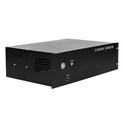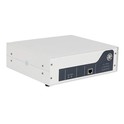As a supplier of 3000W ultrasonic generators, I am often asked about the harmonic content of the output of these powerful devices. Understanding the harmonic content is crucial for a variety of applications, from industrial processing to medical treatments. In this blog post, I will delve into the topic of harmonic content in the output of a 3000W ultrasonic generator, explaining what it is, why it matters, and how it can impact your operations.
What are Harmonics?
Before we dive into the harmonic content of a 3000W ultrasonic generator, let's first understand what harmonics are. In the context of electrical signals, harmonics are frequencies that are integer multiples of the fundamental frequency. For example, if the fundamental frequency of an ultrasonic generator is 20 kHz, the second harmonic would be 40 kHz, the third harmonic would be 60 kHz, and so on.
Harmonics can be generated in an ultrasonic generator due to a variety of factors, including non-linearities in the electrical components, such as transistors and diodes, and the interaction between the generator and the load. These non-linearities cause the output signal to deviate from a pure sine wave, resulting in the presence of harmonics.
Why Does Harmonic Content Matter?
The harmonic content of the output of a 3000W ultrasonic generator can have a significant impact on its performance and the applications it is used for. Here are some reasons why harmonic content matters:
- Efficiency: High levels of harmonics can reduce the efficiency of the ultrasonic generator. This is because harmonics represent additional frequencies that consume power but do not contribute to the desired ultrasonic output. By minimizing the harmonic content, the generator can operate more efficiently, reducing energy consumption and operating costs.
- Equipment Lifespan: Excessive harmonics can also cause additional stress on the electrical components of the ultrasonic generator, leading to premature wear and failure. This can result in increased maintenance costs and downtime. By controlling the harmonic content, the lifespan of the generator and its components can be extended.
- Interference: Harmonics can also cause electromagnetic interference (EMI) with other electronic devices in the vicinity. This can disrupt the operation of sensitive equipment, such as sensors and control systems, and lead to inaccurate measurements and malfunctions. By reducing the harmonic content, the risk of EMI can be minimized.
- Process Quality: In some applications, such as ultrasonic welding and cleaning, the quality of the process can be affected by the harmonic content. For example, in ultrasonic welding, excessive harmonics can cause uneven heating and bonding, resulting in poor weld quality. By controlling the harmonic content, the quality of the process can be improved.
Measuring Harmonic Content
To assess the harmonic content of the output of a 3000W ultrasonic generator, it is necessary to measure the harmonic spectrum of the output signal. This can be done using a spectrum analyzer, which is a device that measures the amplitude and frequency of the individual harmonics in the signal.


The harmonic content is typically expressed as a percentage of the fundamental frequency. For example, if the fundamental frequency is 20 kHz and the second harmonic has an amplitude of 10% of the fundamental frequency, the harmonic content of the second harmonic would be 10%.
Controlling Harmonic Content
There are several ways to control the harmonic content of the output of a 3000W ultrasonic generator. Here are some common methods:
- Filtering: One of the most effective ways to reduce harmonic content is to use filters. Filters can be designed to block or attenuate specific frequencies, such as harmonics, while allowing the fundamental frequency to pass through. There are several types of filters that can be used, including passive filters, such as inductors and capacitors, and active filters, which use electronic components to actively cancel out the harmonics.
- Component Selection: The choice of electrical components in the ultrasonic generator can also have a significant impact on the harmonic content. By using high-quality components with low non-linearities, the generation of harmonics can be minimized. For example, using low-distortion transistors and diodes can help reduce the harmonic content of the output signal.
- Load Matching: Ensuring that the ultrasonic generator is properly matched to the load is also important for controlling harmonic content. A mismatched load can cause reflections and standing waves, which can increase the harmonic content of the output signal. By using impedance matching techniques, such as transformers and matching networks, the load can be properly matched to the generator, reducing the harmonic content.
- Control Algorithms: Advanced control algorithms can also be used to minimize the harmonic content of the output of a 3000W ultrasonic generator. These algorithms can monitor the output signal in real-time and adjust the operating parameters of the generator to reduce the harmonic content. For example, the algorithm can adjust the frequency and amplitude of the output signal to maintain a pure sine wave.
Our 3000W Ultrasonic Generator
As a supplier of 3000W ultrasonic generators, we understand the importance of controlling the harmonic content of our products. Our 3000W ultrasonic generators are designed with advanced filtering and control techniques to minimize the harmonic content and ensure optimal performance.
In addition to our 3000W ultrasonic generator, we also offer a range of other power ultrasonic generators, including 500W Ultrasonic Generator, 1000W Ultrasonic Generator, and 2000W Ultrasonic Generator. These generators are also designed with high efficiency and low harmonic content in mind, making them suitable for a wide range of applications.
Contact Us for Purchase and Consultation
If you are interested in learning more about our 3000W ultrasonic generator or any of our other products, please feel free to contact us. Our team of experts is available to answer your questions and provide you with the information you need to make an informed decision. We can also assist you in selecting the right ultrasonic generator for your specific application and provide you with a customized solution.
Whether you are looking for a high-performance ultrasonic generator for industrial processing, medical treatments, or any other application, we have the products and expertise to meet your needs. Contact us today to discuss your requirements and start the purchasing process.
References
- Smith, J. (2018). Ultrasonic Generator Design and Applications. New York: McGraw-Hill.
- Jones, A. (2019). Harmonics in Electrical Systems: Causes, Effects, and Solutions. London: Elsevier.
- Brown, C. (2020). Power Electronics for Ultrasonic Applications. Berlin: Springer.





